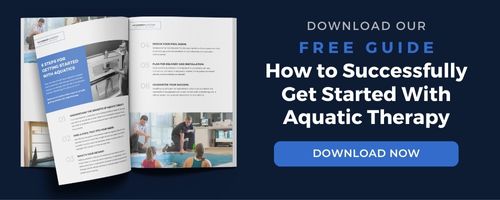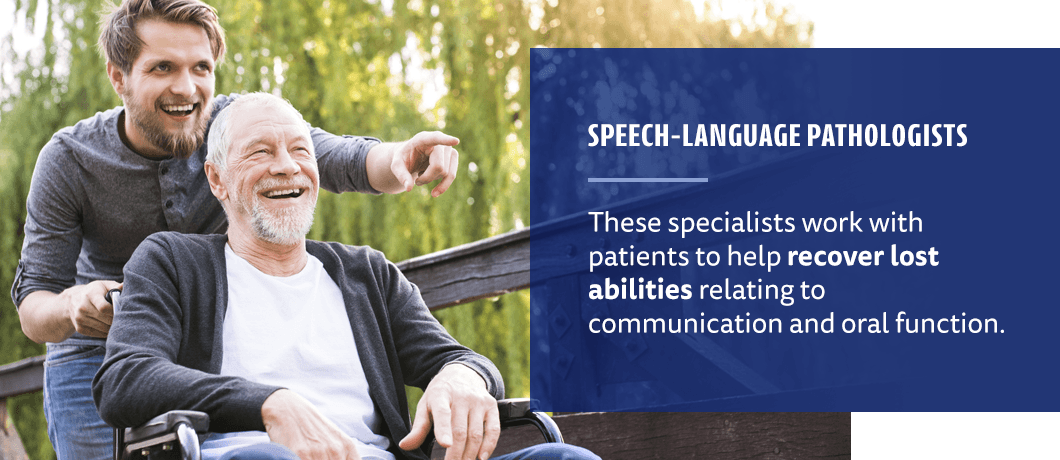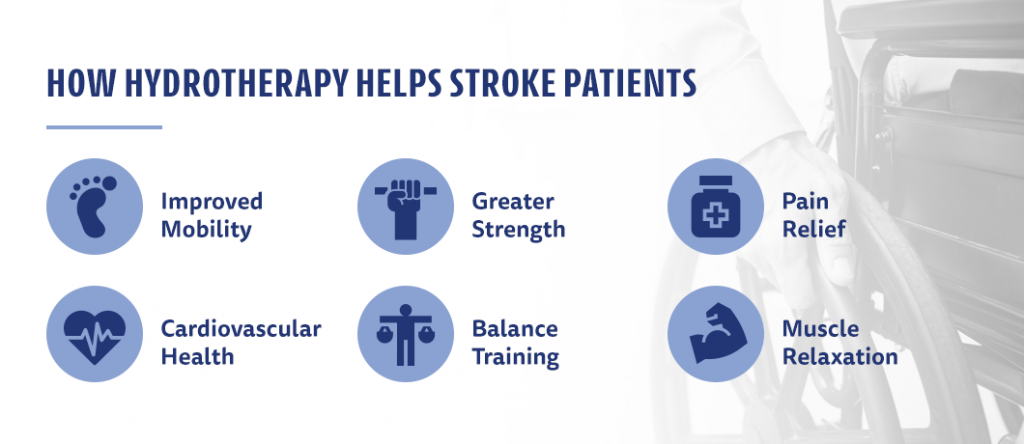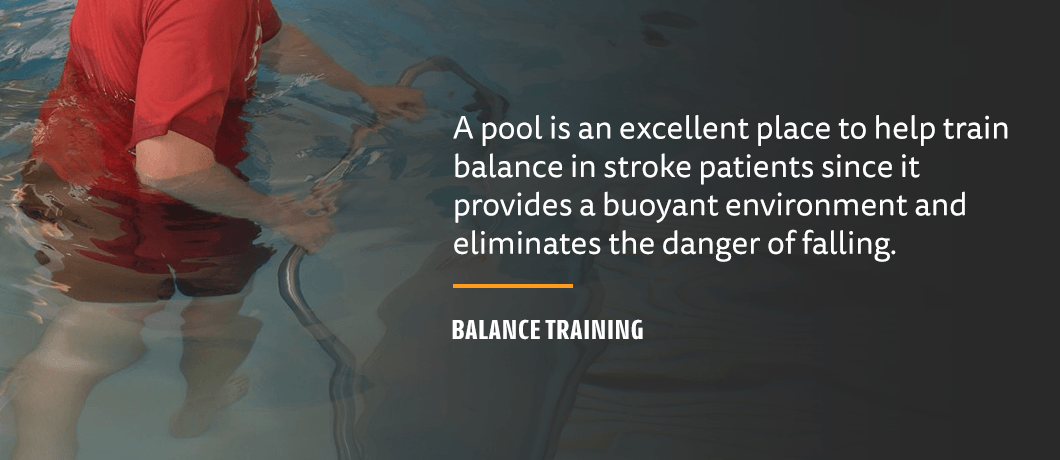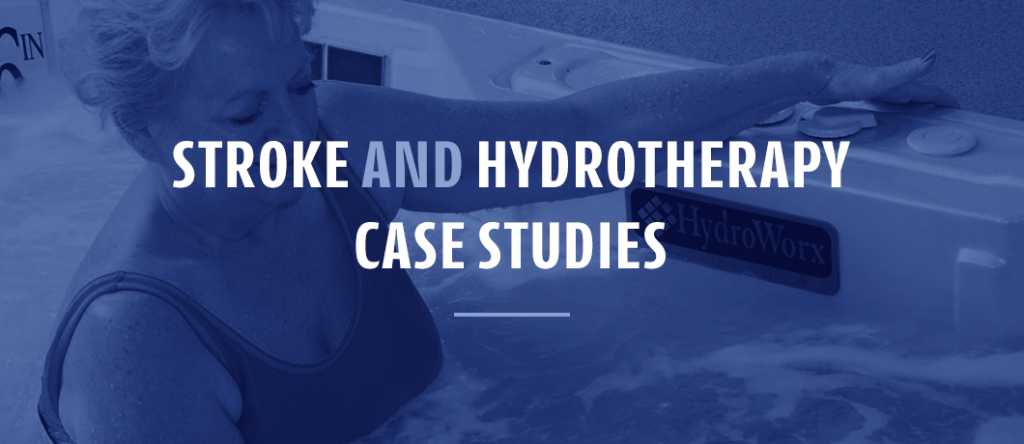Stroke is one of the leading causes of long-term disability, with the CDC reporting that strokes reduced mobility in over half of survivors over the age of 65. Affecting almost 800,000 Americans annually, the long-term effects of strokes vary from patient to patient, leading to minor or severe impairments — such as minor weakness in the limbs to partial paralysis. The majority of stroke survivors do require some level of physical rehabilitation to help them achieve some degree of normal functionality. For many, hydrotherapy has proven highly effective.
Jump to Sections:
- Treating Stroke Patients With Hydrotherapy
- What is a Stroke?
- Treatments for Stroke Patients
- How Hydrotherapy Helps Stroke Patients
- Hydrotherapy Exercises for Stroke Patients
- Stroke and Hydrotherapy Case Studies & Research
- Request More Information About Hydrotherapy Equipment From HydroWorx
TREATING STROKE PATIENTS WITH AQUATIC THERAPY
Hydrotherapy, also known as aquatic therapy or aqua therapy, is a type of recreational therapy that includes completing exercises in a therapy pool. This type of physical activity can serve as an excellent treatment for stroke patients, providing a safe yet effective exercise environment.
Water has been used in therapy for centuries, with the pressure of submersion helping to alleviate aches and pains, especially when taking place in a heated pool. When combined with targeted exercises, aquatic therapy for stroke patients is an excellent way for patients to relearn physical skills without placing undue stress on their bodies.
WHAT IS A STROKE?
Strokes happen when a part of the brain is deprived of blood. This can occur due to a blood vessel bursting, known as a hemorrhagic stroke, or as the result of a blocked artery, as with an ischemic stroke. The brain tissue in the affected area is deprived of nutrients and oxygen, causing damage to the brain cells over time. The person loses functionality associated with that part of the brain as the cells die. As a result, the specific effects of a stroke will vary from person to person, depending on the area of the brain affected and the severity of the stroke — for example, damage to the left side of the brain will affect the right side of the body and will most likely cause problems in speech and language processing. Some of the possible symptoms of stroke include:
- Paralysis and Loss of Movement: If the stroke affected a part of the brain controlling muscle movement, a stroke patient might lose some or all of their ability to move that part of the body. The effects of paralysis and loss of muscular control can usually be reduced with physical therapy.
- Pain and Sensitivity Changes: Pain, numbness and other sensations are common after a stroke, often affecting specific areas of the body. Patients may also notice that they react to certain sensations differently, feeling cold and warm more intensely.
- Difficulty Talking and Swallowing: Some strokes affect a patient’s ability to control the muscles in the mouth and throat. This can make it difficult to talk, swallow or eat, depending on the extent of the issue. Speech-language pathologists can often help regain some or all of this functionality.
- Difficulty Communicating: If a stroke affects the area of the brain that processes speech, it may be difficult for a stroke patient to speak, understand speech, read or write, and they may have to relearn these skills with the help of a speech-language pathologist.
- Cognition and Memory Loss: Many stroke survivors experience some level of memory loss, whether short- or long-term. Some patients may also experience difficulty with certain thinking processes and may have a harder time making judgments, reasoning and understanding certain concepts.
- Emotional Problems: People who have experienced a stroke will often be emotionally affected by the experience to some extent, but some effects can be the direct result of a stroke. Stroke patients may have more difficulty controlling their emotions or may develop depression due to changes in brain chemistry.
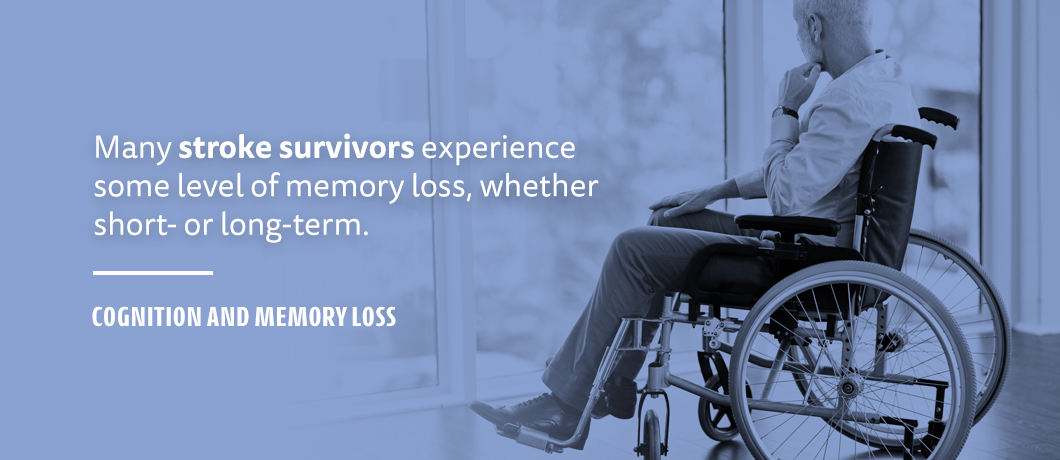
TREATMENTS FOR STROKE PATIENTS
Following a stroke, the treatment options for patients vary widely based on the specific difficulties they experience, but all of them focus on helping the patient recover as much function as possible so that they can return to their activities of daily living. Typically, stroke patients will work with a team to target the specific effects of their stroke — this team usually includes the following specialists:
- Speech-Language Pathologists: These specialists work with patients to help recover lost abilities relating to communication and oral function. If the patient has difficulty swallowing, eating or controlling the mouth muscles, speech-language pathologists will help them develop a program to regain control of these muscles. As for communication issues, speech-language pathologists will help identify the extent of communication loss, whether it is in understanding speech, formulating speech, reading or writing. Often, the specialist will help the patient regain their lost function or develop a method of communication that allows them to function with their new level of ability.
- Occupational Therapists: Occupational therapists help patients with daily life functions, assisting them in relearning how to navigate their home with their new level of ability. Often, occupational therapists will work with the patient to get them mobility aids or modifications to the home that will ensure their safety and functionality in their daily life. They’ll also help the patient relearn how to do everyday life tasks, like navigating stairs or preparing meals.
- Physical Therapists: Physical Therapists help patients regain physical abilities, with a specific focus on daily tasks like walking, sitting and standing. Most commonly, physical therapists work with stroke patients on gait training, helping patients improve their gait so that they can move from place to place.
- Psychologist or Psychiatrist: Strokes not only affect brain functionality, but they can have a devastating effect on the emotional health of the patient. Many patients experience depression or emotional distress following a stroke and have difficulty adjusting to their new level of ability. Working with a psychologist and psychiatrist to overcome these emotional hurdles and get medication to treat chemical imbalances in the brain can help patients adjust and improve their emotional health through the treatment process.
HOW HYDROTHERAPY HELPS STROKE PATIENTS
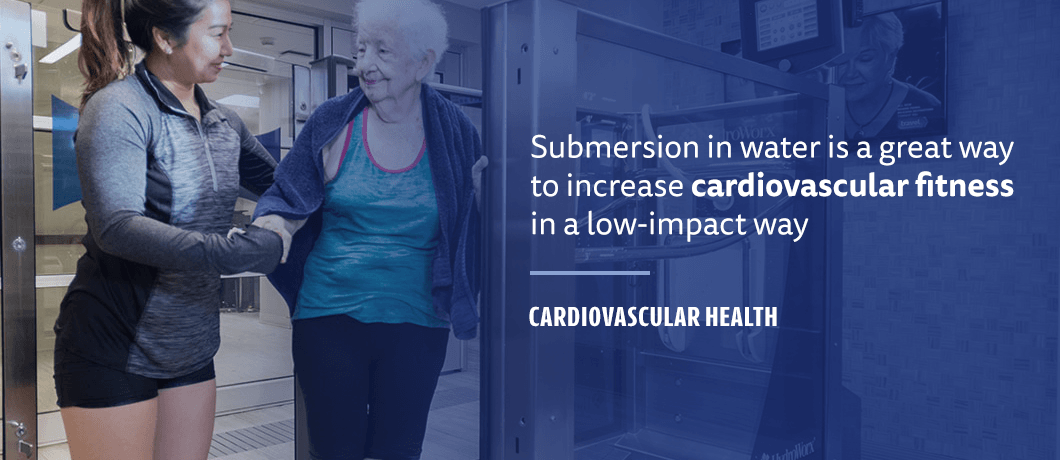
Aquatic therapy is especially helpful in treating stroke patients. The water provides a safe place for relearning skills and retraining the body, regardless of the patient’s level of mobility. Some of the benefits of aquatic therapy for stroke patients include:
- Improved Mobility: Submersion in water decreases the body weight of an individual by up to 90 percent, making it easier for stroke patients to move without placing stress on their joints. At the same time, the water’s viscosity means that a person moves more slowly through it — in this way, water provides extra support for the body, allowing a stroke patient to work on balance and coordination more freely. Combined, these two aspects of water provide an excellent therapy environment for stroke paralysis. Patients can work on range-of-motion exercises and simulated walking in the water, even if they are not strong enough to complete these exercises on land, and they can get extra support from flotation devices whenever necessary.
- Greater Strength: Due to the viscosity or natural resistance of water, it’s possible to gain more strength in less time when exercising in water. The natural resistance provided by moving in water means that every session is a strength workout. Additionally, working out in water makes it easier to target areas of the body that a patient might not be able to on land — for example, a patient whose legs are too weak to support them might not be able to do squats and lunges on land, but they might be able to do so in water. In this way, patients are better able to work toward regaining lost abilities like walking.
- Pain Relief: Water isn’t just a good exercise environment, it’s also a good pain reliever. The pressure provided by water effectively massages the muscles, reducing pain during and after a session. These effects are heightened when the water is kept warm, usually around body temperature. Warm water helps reduce tension in the body while also stimulating the release of endorphins, the body’s natural painkillers.
- Cardiovascular Health: Submersion in water is a great way to increase cardiovascular fitness in a low-impact way. By simply standing in water, the increased pressure on the body forces the heart to work harder to move blood, increasing the heart’s fitness over time. Cardiovascular health not only helps increase a stroke patient’s endurance, but it can also help reduce the risk of the patient experiencing another stroke.
- Balance Training: Since strokes tend to affect one side of the body over another, stroke patients tend to have issues with their balance, making it difficult to walk or perform daily activities. Aquatic therapy can help with this, providing a safe environment for balance training. Hydrotherapy, in fact, is often more effective than land-based training in this area, since water protects the patient from falling as they work through their exercises. The patient can be progressed by adding water disturbances manually or with a resistance jet to increase the difficulty.
- Muscle Relaxation: Muscle spasticity is a common problem in stroke patients, resulting in stiff or rigid muscles that can become painful over time. Hydrotherapy, especially in a warm pool, can help relax these muscles, reducing spastic episodes and allowing the patient and their therapist to work toward lengthening the muscle.
On top of all these benefits, working out in the water can be a fun and stimulating experience for stroke patients, especially in group settings. Not only do the patients get a good exercise in the water, but they also affect their emotional well-being by gaining a sense of progress and independence. All of these factors combined help make the road to recovery that much smoother.
HYDROTHERAPY EXERCISES FOR STROKE PATIENTS
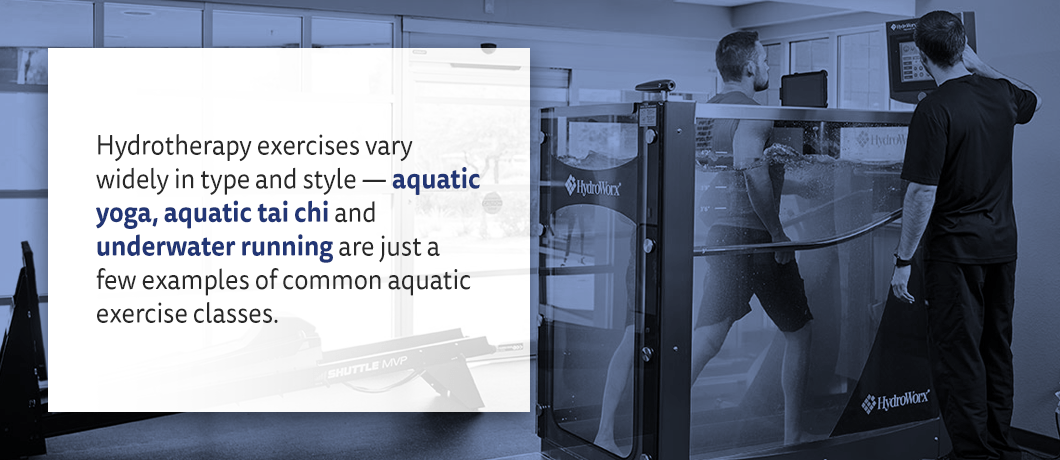
- Stretching: Stretching and relaxation exercises, such as passive range of movement exercises, are great for any stroke patient, but especially for those dealing with spasticity or reduction in mobility. Stretching exercises in the water can be particularly effective since the patient is able to move muscles and joints differently than they can on land, achieving a greater range of motion. An example of this type of exercise would be floating in the water and having an assistant guide the trunk of the body to bend the spine from side to side. Often, stretching exercises involve alternating between contracting and stretching the muscles, which can help relax the muscle and reduce pain in daily activities.
- Strength Training: Like squats and leg kicks. Often, this type of training uses aquatic exercise equipment like aquatic dumbbells, hand paddles and ankle weights to increase resistance or target specific areas of the body. This type of training can increase strength as well as allow patients to target deep muscles without placing undue stress on their joints. Even patients who are unable to stand on land can complete exercises in the water to improve leg strength, like squats and lunges, using flotation devices and the natural buoyancy provided by water. These types of exercises are excellent for all stroke patients trying to recover from a loss of muscle function.
- Cardiovascular Training: Common exercises include swimming, walking, cycling and jumping in the water, depending on the level of ability of the patient. Even patients who cannot use their legs can complete cardiovascular exercises involving moving the upper limbs. Cardiovascular training is a staple of aquatic therapy for stroke patients since it can help improve endurance while also preventing future strokes. Just being in water can help improve cardiovascular fitness by forcing the heart to work harder to move blood through the body. When paired with aerobic exercises, like swimming for stroke patients, this can result in excellent cardiovascular training.
- Balance Training: Patients can work on their balance in the pool by standing on one leg, closing their eyes or increasing water turbulence while completing other exercises. These exercises are particularly helpful for stroke patients struggling with mobility or adjusting to reduced functionality on one side of the body. A pool is an excellent place to help train balance in stroke patients since it provides a buoyant environment and eliminates the danger of falling.
Certified hydrotherapy specialists will often incorporate all of the above exercise types into their program, but they will focus more on exercise types that specifically cater to the needs of the patient. With any of these exercises, resistance can be increased or decreased by adjusting the speed of the motions being performed and the equipment they are performed with. Therapists may also adjust exercises to suit the changing needs of their patients, increasing intensity as their patients gain more functionality.
STROKE AND HYDROTHERAPY CASE STUDIES
Aquatic therapy has seen a lot of success among stroke patients across the world. Here are just a couple of examples of patients who saw real results with hydrotherapy:
- Vital Energy Wellness and Rehab Center in Lexington, SC reported that one of their patients had seen excellent results with hydrotherapy. The patient, a stroke survivor who lives with paralysis on her right side and severe osteoarthritis in both knees, was unable to stand, walk or perform daily functions on her own. Using warm water therapy in a HydroWorx pool, the therapists at Vital Energy have helped her reduce her level of pain to the point where she can now roll over in bed and assist with transfers from a bed or chair to a wheelchair.
- Pieters Family Life Center has been working with Lois Jordan for months after a stroke that left her almost completely paralyzed. After her stroke, Lois was told that she would never walk again, but after five months of aquatic therapy, Lois can walk on her own in the water. She can also now get up from a bed and walk with a walker in her daily life.
- Another case from Pieters Family Life Center is that of Chuck Ciraolo. He suffered a stroke that was so severe, doctors told his family he would likely be unable to regain any movement. It has taken time, but after weekly aquatic therapy sessions in the HydroWorx 2000 Series pool, he has regained much of his balance to be able to return to activities such as mowing the lawn and riding his four-wheeler. He was even able to walk his daughter down the aisle at her wedding.
- Lois Jordan suffered a stroke that left her almost completely paralyzed. Before she started aquatic therapy, she was told she would never walk again and her hopes of improving her mobility were all but dashed. Today, after only 5 months of aquatic therapy with Barb Cacia, Wellness Director at Pieters Family Life Center, in their HydroWorx pool, Lois has made vast improvements. She can now walk on her own in the water and has advanced to the point of being able to use a walker when on land. She is able to get herself out of bed in the morning and transition from sitting to standing and walking with little to no help. Although recovering from a stroke is a lifelong process, aquatic therapy has helped restore not only Lois’s mobility and growing independence, but her hope and confidence in a future yet to come.
Research
Rehabilitation for stroke sufferers is necessary to lessen the chance of falls and injury. It also helps to prevent muscle, tendon and ligament strain due to poor gait habits and minimal exercise. Proper rehab also improves stroke victims’ overall quality of life by making it easier for them to safely, comfortably and freely engage in activities of daily living. Though land-based treadmills have been regularly used for physical therapy purposes, a breakthrough study from researchers at the Republic of Korea’s Department of Rehabilitation Medicine and Jeju National University School of Medicine, Jeju National University Hospital shows that underwater treadmills may be a better early intervention fit for those who have had stroke episodes.
The study, “Peak Cardiorespiratory Responses of Patients with Subacute Stroke During Land and Aquatic Treadmill Exercise”, was released to the public in August 2016. It focused on evaluating 21 subjects who had experienced stroke within two years of the paper’s research. During the research process, the subjects’ peak VO2, metabolic equivalents, perceived exertion and heart rates were documented during exercise on land-based treadmills and aquatic treadmills. The results were fascinating and dovetail with other research done on aquatic therapy:
- Peak VO2 was higher on the aquatic treadmill.
- Metabolic equivalents were higher on the aquatic treadmill.
- Perceived exertion was higher on the aquatic treadmill.
- Heart rates were similar on both the aquatic and land-based treadmill.
These findings are particularly notable due to water’s unique properties and usefulness when helping stroke sufferers who have limited ambulatory capacities. A water-based modality allows for early intervention, even if the patient has virtually no mobility to safely exercise on land. In the water, the patient’s body weight can be offset by up to 80%, enabling security and eliminating the chances of injury during rehab.
As regular HydroWorx users know, physical therapists throughout the United States are already taking advantage of water’s advantages for their stroke clients.
While available clinical research is still sparse when it comes to the benefits of hydrotherapy, physical therapists are growing increasingly interested in the possibilities of hydrotherapy. With time and research, aquatic therapy is sure to become a new standard treatment option for stroke patients.
Getting Started
The benefits of aquatic therapy for stroke patients are numerous, and it is one of the best options for stroke patients looking for a safe exercise that can help them regain their physical functions. For both patients and clinics, hydrotherapy is an option worth exploring.


